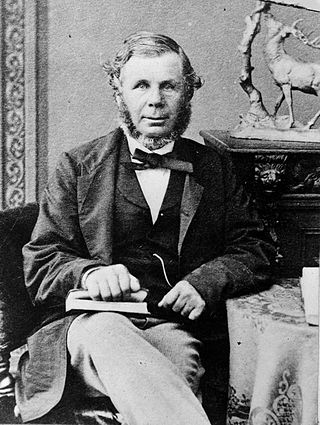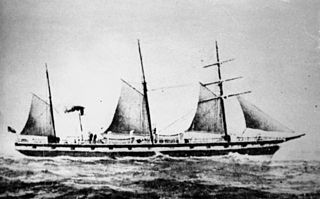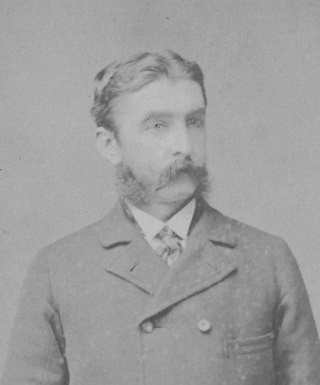Related Research Articles


Akaroa is a small town on Banks Peninsula in the Canterbury Region of the South Island of New Zealand, situated within a harbour of the same name. The name Akaroa is Kāi Tahu Māori for "Long Harbour", which would be spelled Whangaroa in standard Māori. The area was also named Port Louis-Philippe by French settlers after the reigning French king Louis Philippe I.
The cluster of rocks that is Barrett Reef is one of the most hazardous reefs in New Zealand.

The 1884 New Zealand general election was held on 22 July to elect a total of 95 MPs to the 9th session of the New Zealand Parliament. The Māori vote was held on 21 July. A total number of 137,686 (60.6%) voters turned out to vote. In 11 seats there was only one candidate.
Akaroa was a New Zealand electorate. It was located in Banks Peninsula, Canterbury, and named after the town of the same name. One of the original 24 electorates, it existed from 1853 to 1893.

William John Alexander Montgomery was a New Zealand politician from Little River on Banks Peninsula, and a merchant. Born in London, he lived in a number of places and pursued a number of occupations before settling in Christchurch, New Zealand.

Lyttelton Harbour / Whakaraupō is a major inlet on the northwest side of Banks Peninsula, on the coast of Canterbury, New Zealand; the other major inlet is Akaroa Harbour, which enters from the southern side of the peninsula. Whakaraupō enters from the northern coast of the peninsula, heading in a predominantly westerly direction for approximately 15 km (9.3 mi) from its mouth to the aptly-named Head of the Bay near Teddington. The harbour sits in an eroded caldera of the ancient Banks Peninsula Volcano, the steep sides of which form the Port Hills on its northern shore.

SS Akaroa was a UK steam ocean liner and refrigerated cargo ship. She was launched in 1914 in Ireland as Euripides for Aberdeen Line. When new, she was the largest ship in the Aberdeen Line fleet.

Robert Heaton Rhodes was a New Zealand politician, who represented the Akaroa electorate from 1871 to 1874, when he resigned. He was elected unopposed in 1871.

SS Gothenburg was an iron-hulled sail- and steamship that was built in England in 1854 and sailed between England and Sweden until 1862. She then moved to Australia, where she operated across the Tasman Sea to and from New Zealand until 1873, when she was rebuilt. After her rebuild, she operated in the Australian coastal trade.

Pocklington Reef is a coral reef and a mostly submerged atoll in the far southeast of Papua New Guinea.
Ellesmere was a parliamentary electorate in the Canterbury region of New Zealand. It existed for two periods between 1861 and 1928 and was represented by six Members of Parliament.

Walter Hippolyte Pilliet JP was a 19th-century Member of Parliament in Christchurch, New Zealand. He worked initially as a surveyor and was then resident magistrate in several places. He was a newspaper editor and was represented in Parliament for one term.

Akaroa Harbour, is part of Banks Peninsula in the Canterbury region of New Zealand. The harbour enters from the southern coast of the peninsula, heading in a predominantly northerly direction. It is one of two major inlets in Banks Peninsula, on the coast of Canterbury, New Zealand; the other is Lyttelton Harbour on the northern coast.

Okains Bay is a settlement, beach and bay on the Banks Peninsula in the South Island of New Zealand.
The following index is provided as an overview of and topical guide to Wikipedia's articles on recreational dive sites. The level of coverage may vary:

Recreational dive sites are specific places that recreational scuba divers go to enjoy the underwater environment or for training purposes. They include technical diving sites beyond the range generally accepted for recreational diving. In this context all diving done for recreational purposes is included. Professional diving tends to be done where the job is, and with the exception of diver training and leading groups of recreational divers, does not generally occur at specific sites chosen for their easy access, pleasant conditions or interesting features.

The Banks Peninsula Volcano is an extinct volcanic complex to the east of Christchurch on New Zealand's South Island. While the volcano is highly eroded it still forms the majority of Banks Peninsula with a highest point of 919 m (3,015 ft). It is a composite of two main eruptive centres one originating at Lyttelton Harbour, the other at Akaroa Harbour. The eruptions were predominantly basaltic, with associated andesite and trachytes, with minor rhyolite. The volcanic activity occurred in the Late Miocene and possibly extended into the Early Pliocene. There are four volcanic groups, all of which are within the Māui Supergroup. The Christchurch earthquakes led to rumors of a possible eruption, however, there is no known magma chamber beneath the volcano and there has not been any sign of volcanic activity in the last 5 million years.

Little Akaloa is a small settlement and bay on Banks Peninsula, in the South Island of New Zealand.
References
- ↑ "AKAROA MAIL AND BANKS PENINSULA ADVERTISER". Papers Past. 7 November 1884.
- 1 2 Locker-Lampson & Francis, S & J (1994). Rediscovered New Zealand Shipwrecks: The Wreck Book. Auckland: The Halcyon Press. p. 28. ISBN 0-908685-82-3.